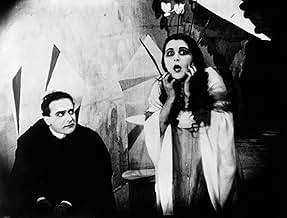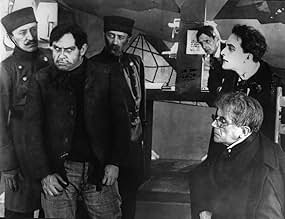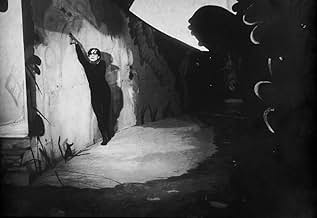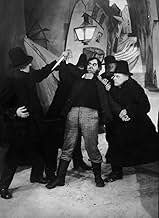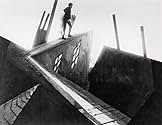AVALIAÇÃO DA IMDb
8,0/10
74 mil
SUA AVALIAÇÃO
O hipnotizador Dr. Caligari usa Cesare, que é um sonâmbulo, para cometer assassinatos.O hipnotizador Dr. Caligari usa Cesare, que é um sonâmbulo, para cometer assassinatos.O hipnotizador Dr. Caligari usa Cesare, que é um sonâmbulo, para cometer assassinatos.
- Direção
- Roteiristas
- Artistas
- Prêmios
- 2 vitórias e 1 indicação no total
Friedrich Feher
- Franzis
- (as Friedrich Fehér)
Hans Heinrich von Twardowski
- Alan
- (as Hans Heinz v. Twardowski)
Rudolf Lettinger
- Dr. Olsen
- (as Rudolph Lettinger)
Rudolf Klein-Rogge
- Ein Verbrecher
- (não creditado)
- …
Hans Lanser-Ludolff
- Ein Alter Mann
- (não creditado)
- …
Henri Peters-Arnolds
- Ein Junger Arzt
- (não creditado)
- …
Ludwig Rex
- Ein Mörder
- (não creditado)
- …
Elsa Wagner
- Die Wirtin
- (não creditado)
- …
- Direção
- Roteiristas
- Elenco e equipe completos
- Produção, bilheteria e muito mais no IMDbPro
Avaliações em destaque
I vowed to see more horror films this year, and this was recommended to me, initially I was a little dubious with it being a hundred plus years old, and a silent film, but I have to say I have a real appreciation for it.
Without a doubt, this film must be the inspiration for the whole horror genre, a genre that scares and shocks people to this day, you can only I shine the profound effect that this film must have had on viewers back in its time.
Hugely atmospheric and creepy, if I'm honest, it is slow, and you do need to concentrate, or you'll lose it, no texting or phone play, it is a fairly intense watch, best of all is the ending, which really does come as a surprise, it's something of a twist.
It is definitely not for everyone, and if you're used to modern horror, you may find ten minutes of it an arduous task, but having watched Nose earlier in the year, I have a real appreciation for this early gem.
An admirable film, 8/10.
Without a doubt, this film must be the inspiration for the whole horror genre, a genre that scares and shocks people to this day, you can only I shine the profound effect that this film must have had on viewers back in its time.
Hugely atmospheric and creepy, if I'm honest, it is slow, and you do need to concentrate, or you'll lose it, no texting or phone play, it is a fairly intense watch, best of all is the ending, which really does come as a surprise, it's something of a twist.
It is definitely not for everyone, and if you're used to modern horror, you may find ten minutes of it an arduous task, but having watched Nose earlier in the year, I have a real appreciation for this early gem.
An admirable film, 8/10.
10clurge-2
Like so many of the films from the silent era, The Cabinet of Dr. Caligari gets overlooked (if you can even find it!) for big budget duds, and runny romantic comedies. Directors of the period like Griffith, Lang, Eisenstien, and Caligari's Wiene, are never given the credit they deserve. And if credit is given, it is in small cultish circles in various pockets around the world.
The set design here is amazing, not a single right angle can be found in any one of the sets. This may not only apply to the disjointed and distorted characters in the film, but also the state of Germany at the time. After all, the film was made in the dark ages in Germany between WWI and WWII. This point is validated by Siegfried Kracauer, with his notion of how the main character of Dr. Caligari can be easily interpreted to Hitler, and vice versa. Both controlled subjects with a form of "brainwashing", both were upset with current forms of society and government, and both were masters of deception. In a period where Germans were looking for direction, and let's face it, authority as well, Dr. Caligari embodied it fully.
In the area of the players, all the names in the film turn out a literally "speechless" performance. Dagover, Krauß, and especially Veidt as Cesare (pronounced Chez-a-ray) are excellent in the use of gestures and motion to get their point across without using words. The camera, stationary as in most early features, uses the mise-en-scene effectively, letting us identify with characters such as Francis and Jane, and disjointing us from Caligari, and the Criminal.
The use of lines and stripes, not only in the sets but in small places like in the good doctor's hair and on his gloves, adds to the telling of the character. Colour tints of the B&W film also play a special part in bringing the whole film together. An amazing sequence where Caligari reveals his true madness, pits Caligari stumbling through the unequal streets of Germany while being haunted by textual ramblings written in the air. A marvelous achievement for it's time. And it adds so much.
The Cabinet Of Dr. Caligari has changed the way I look at horror films, and even films in general. I urge anyone reading this to pick up this film. The DVD offering is utterly fantastic with the restored print, an audio essay of the film, and production notes. Bypass the overblown "motion picture events of the year", and pick up Caligari, quite possible the greatest motion picture event in the history of motion pictures.
The set design here is amazing, not a single right angle can be found in any one of the sets. This may not only apply to the disjointed and distorted characters in the film, but also the state of Germany at the time. After all, the film was made in the dark ages in Germany between WWI and WWII. This point is validated by Siegfried Kracauer, with his notion of how the main character of Dr. Caligari can be easily interpreted to Hitler, and vice versa. Both controlled subjects with a form of "brainwashing", both were upset with current forms of society and government, and both were masters of deception. In a period where Germans were looking for direction, and let's face it, authority as well, Dr. Caligari embodied it fully.
In the area of the players, all the names in the film turn out a literally "speechless" performance. Dagover, Krauß, and especially Veidt as Cesare (pronounced Chez-a-ray) are excellent in the use of gestures and motion to get their point across without using words. The camera, stationary as in most early features, uses the mise-en-scene effectively, letting us identify with characters such as Francis and Jane, and disjointing us from Caligari, and the Criminal.
The use of lines and stripes, not only in the sets but in small places like in the good doctor's hair and on his gloves, adds to the telling of the character. Colour tints of the B&W film also play a special part in bringing the whole film together. An amazing sequence where Caligari reveals his true madness, pits Caligari stumbling through the unequal streets of Germany while being haunted by textual ramblings written in the air. A marvelous achievement for it's time. And it adds so much.
The Cabinet Of Dr. Caligari has changed the way I look at horror films, and even films in general. I urge anyone reading this to pick up this film. The DVD offering is utterly fantastic with the restored print, an audio essay of the film, and production notes. Bypass the overblown "motion picture events of the year", and pick up Caligari, quite possible the greatest motion picture event in the history of motion pictures.
With a story as twisted, buckled and demented as the scenery and set design, and a tortured score to boot, was the lunatic in charge of the asylum? Must have been a moment to remember coming across this cinematic marvel back in 1920. I wonder how many of today's pieces of cinema will stand the test of 100 years, albeit with a lot more competition.
Having only started discovering silent movies recently, I don't have more than a handful of other non-talkies to compare it to. This however was not only one of the best, most compelling and unique silents I have seen, but also a great flick overall. It's all been said before, I'm sure, but I'll say it again: this is a milestone of German Expressionist cinema. It is also a class-A mind-phuck movie (excuse my French), one of those stories that'll leave you eternally scratching your head trying to figure out what you've seen, what to believe and what can be a plausible explanation for most of the creepy mysteries you've just witnessed. Right from the very opening scene, seemingly suspended in an otherworldly dimension, maybe somewhere in between life and death, in which the first line spoken is: "There are spirits everywhere", you realise you are in for a spooky ride (this is the ultimate Halloween movie, come to think of it!) Having studied theatre set and costume design at Rome's art school for a year before going to university, I was obviously completely fascinated by the set design choices here. Buildings and furniture, props and painted backdrops are elongated and deformed into blocky, savage, expressionistic, perspective-defying and proportion-less forms. Even the intertitles weren't of the traditional sort. The result is obviously one of unsettling the viewer further into believing themselves suspended in a reality where anything could happen - anything horrible or nightmarish, obviously. Nothing is as it seems, right to the very end. Btw, on a more frivolous note, I thought the character of Cesare the Somnambulist looked uncannily like something that might have influenced Tim Burton into creating Edward Scissorhands, or maybe even more, the look of some of the characters in Rocky Horror Picture Show.
This movie was shot between 1919 and 1920, a few decades since the motion picture camera was invented, and the Lumière brothers were in the middle of their experiments with it. At the time, cinema was being considered as a new way of making art, and yo make art you had to marry with a serie of ideas: ideology, aesthetics, cosmogony, etc. In these terms, this movie belongs to the German expressionism, which is reflected in the entire setup: from characters make up to the background of the set.
Having an average murder-mystery plot, the movie can be defined as a painting with some action occurring in it. The whole scenario was displayed following the same criteria as in expressionist painting: all diagonal and curve lines, evading the straightness and the cardinal orientation of things, wicked perspectives and proportions. Even the more minimum detail was carefully considered to fulfill the aesthetics needs. The result couldn't have been better, considering that the only visual trick they could do was to shrink/enlarge the camera's diafragma. Think that this was before the concept of travelling was even developed.
Concerning the plot, yet it's true that it isn't really the great thing and that many people now a days find it boring, I got to enjoy it, further than its aesthetical function (I even got to laugh in a couple of scenes), and I highly recommend it, as a good old piece of art from which many of today's film makers may take some good lessons on how to approach movies. I'm sure that if they got understand that, then there would be much lesser crappy movies than there are now a days.
Having an average murder-mystery plot, the movie can be defined as a painting with some action occurring in it. The whole scenario was displayed following the same criteria as in expressionist painting: all diagonal and curve lines, evading the straightness and the cardinal orientation of things, wicked perspectives and proportions. Even the more minimum detail was carefully considered to fulfill the aesthetics needs. The result couldn't have been better, considering that the only visual trick they could do was to shrink/enlarge the camera's diafragma. Think that this was before the concept of travelling was even developed.
Concerning the plot, yet it's true that it isn't really the great thing and that many people now a days find it boring, I got to enjoy it, further than its aesthetical function (I even got to laugh in a couple of scenes), and I highly recommend it, as a good old piece of art from which many of today's film makers may take some good lessons on how to approach movies. I'm sure that if they got understand that, then there would be much lesser crappy movies than there are now a days.
Você sabia?
- CuriosidadesWriter Hans Janowitz claims to have gotten the idea for the film when he was at a carnival one day. He saw a strange man lurking in the shadows. The next day he heard that a girl was brutally murdered there. He went to the funeral and saw the same man lurking around. He had no proof that the strange man was the murderer, but he fleshed the whole idea out into his film.
- Erros de gravaçãoIn the wide shot, the sign at the asylum reads "Insane Asylum," in English. In the close-up, the sign is written in German (Kino Blu-ray Disc version, may not be present in all editions of the film).
- Versões alternativasUSA laserdisc reissue restores the original hand-drawn title cards that have been missing from every known print of the film since 1923. When first released on video in the United States, film was in black-and-white, and played back many scenes at double speed and featured different music. Although no scenes were cut out, the running time was reduced to only 51 minutes. The restored version restores the colour-tinting, restores the original title cards, and plays the film back at regular speed, returning the film to its original 69-minute running time.
- ConexõesEdited into People Who Die Mysteriously in Their Sleep (2004)
Principais escolhas
Faça login para avaliar e ver a lista de recomendações personalizadas
Detalhes
Bilheteria
- Orçamento
- US$ 18.000 (estimativa)
- Faturamento bruto nos EUA e Canadá
- US$ 8.811
- Faturamento bruto mundial
- US$ 9.297
- Tempo de duração
- 1 h 16 min(76 min)
- Mixagem de som
- Proporção
- 1.37 : 1
Contribua para esta página
Sugerir uma alteração ou adicionar conteúdo ausente


